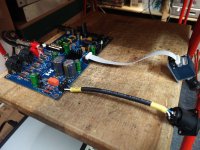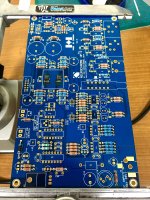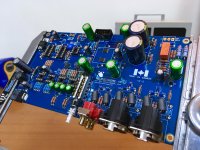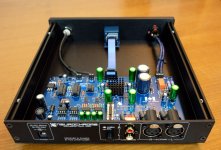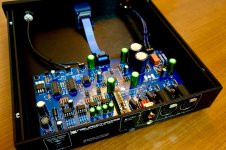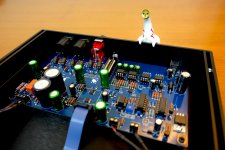@noviygera & @mbrenna -
I try to only post what I'm personally certain of, even if I'm not sure if it will apply to others. I am always terribly reluctant to post any kinds of small details regarding comparisons between amps for a few reasons... some serious and some a bit tongue in cheek.
1) How do you know I'm not deaf in one ear and can't hear out of the other? 😀
2) Unless you care about the same headphones, my impressions likely won't matter very much. I have found that certain headphones and amp combinations work better for me than others (within reason) and likely will for you as well. What I hear from one set of headphones in all likelihood will not apply to others. The HD800S sound the best on one amp (to me) and the HD820 sound better on another (to me). IEMs are really only best-suited to 2 of the amps IMO. The Meze's were fine with all but the Crack.
3) If you care about what tubes I used in the Crack or the Lyr, what OpAmps I used in the WHAMMY, what cables I use etc, or believe those things are meaningful to helping a person choose an amp over another, then my impression won't matter. OH... he only had a stock Tung-Sol in the Lyr.... THAT's why he didn't love it the best 😀
4) We may care about different things in our music.
5) I often use digital EQ, so ...
6) I am a horrible critical listener and didn't take a lot of notes. 😀
7) When I read others' impressions online using the same gear, I often don't agree.
With that said, if anyone would like to know something specific that I can answer - I'll be absolutely transparent with my impressions. Feel free to PM me or ask in the forum if you'd like me to listen to one of your favorite songs between a few amps. I may give it a shot, and I'd get to learn some new music perhaps. What I won't attempt to do is use audiophile terms like "warm ... gooey... flat... dry... tingly.... " etc. to try and describe differences. If I hear a difference... then I'll try to describe it the best I can in terms we all may know. I love listening, I don't like "critical" listening all that much, but I can do my best. If you have particular things you look for in the songs, that's helpful. Don't ask me if someone sounds like they do live or if the guitar sounds exactly like your PRS driven through an old DeVille ... I won't know. 😀
Some other things that were meaningful to me that weren't mentioned.
I love all the amps. I am keeping all the amps.
Tidbits -
1) Lyr 3 does not work well at all for me with IEMs even on low gain. Since I like IEMs and use them a bit - that was a large factor for that use. Still an awesome amp, IMO.
2) ACP+ brings what I might consider the most engaging or "toe-tapping" presentation, but something I can't quite put my finger on... just was missing.
3) I love the WHAMMY. It was the most steady on my desk for a long time. I still may swap back and forth more. I feel like the HP-2 reveals a bit more detail / provides more information... if that makes sense.
4) The Crack is an excellent amp, but it's a PITA for me on a work desktop, and it really only shines with the Senns. It is IMO, the most "forgiving" of all the amps. It's also an amp that reveals changes in tubes, so ... my Crack and many others are likely very different and won't sound the same.
All of this should be taken with a dump truck load of salt. When people describe "Night and Day" differences, I usually hear subtle changes that might waver a bit over time. I like the HP-2 quite a bit, but with the exception of some of the amps' performance with low impedance HPs or IEMs - all the differences are pretty subtle to me.

I try to only post what I'm personally certain of, even if I'm not sure if it will apply to others. I am always terribly reluctant to post any kinds of small details regarding comparisons between amps for a few reasons... some serious and some a bit tongue in cheek.
1) How do you know I'm not deaf in one ear and can't hear out of the other? 😀
2) Unless you care about the same headphones, my impressions likely won't matter very much. I have found that certain headphones and amp combinations work better for me than others (within reason) and likely will for you as well. What I hear from one set of headphones in all likelihood will not apply to others. The HD800S sound the best on one amp (to me) and the HD820 sound better on another (to me). IEMs are really only best-suited to 2 of the amps IMO. The Meze's were fine with all but the Crack.
3) If you care about what tubes I used in the Crack or the Lyr, what OpAmps I used in the WHAMMY, what cables I use etc, or believe those things are meaningful to helping a person choose an amp over another, then my impression won't matter. OH... he only had a stock Tung-Sol in the Lyr.... THAT's why he didn't love it the best 😀
4) We may care about different things in our music.
5) I often use digital EQ, so ...
6) I am a horrible critical listener and didn't take a lot of notes. 😀
7) When I read others' impressions online using the same gear, I often don't agree.
With that said, if anyone would like to know something specific that I can answer - I'll be absolutely transparent with my impressions. Feel free to PM me or ask in the forum if you'd like me to listen to one of your favorite songs between a few amps. I may give it a shot, and I'd get to learn some new music perhaps. What I won't attempt to do is use audiophile terms like "warm ... gooey... flat... dry... tingly.... " etc. to try and describe differences. If I hear a difference... then I'll try to describe it the best I can in terms we all may know. I love listening, I don't like "critical" listening all that much, but I can do my best. If you have particular things you look for in the songs, that's helpful. Don't ask me if someone sounds like they do live or if the guitar sounds exactly like your PRS driven through an old DeVille ... I won't know. 😀
Some other things that were meaningful to me that weren't mentioned.
I love all the amps. I am keeping all the amps.
Tidbits -
1) Lyr 3 does not work well at all for me with IEMs even on low gain. Since I like IEMs and use them a bit - that was a large factor for that use. Still an awesome amp, IMO.
2) ACP+ brings what I might consider the most engaging or "toe-tapping" presentation, but something I can't quite put my finger on... just was missing.
3) I love the WHAMMY. It was the most steady on my desk for a long time. I still may swap back and forth more. I feel like the HP-2 reveals a bit more detail / provides more information... if that makes sense.
4) The Crack is an excellent amp, but it's a PITA for me on a work desktop, and it really only shines with the Senns. It is IMO, the most "forgiving" of all the amps. It's also an amp that reveals changes in tubes, so ... my Crack and many others are likely very different and won't sound the same.
All of this should be taken with a dump truck load of salt. When people describe "Night and Day" differences, I usually hear subtle changes that might waver a bit over time. I like the HP-2 quite a bit, but with the exception of some of the amps' performance with low impedance HPs or IEMs - all the differences are pretty subtle to me.

Here my HP-2 finally completed and playing. Very please with the sound, even if it is still at the prototype stage, awaiting a chassis. It is cut from the same cloth as its bigger brother the HP-1. Very revealing and detailled sound, pitch black background, plenty of gain. I did a detailled study of its circuitry, and I can tell you it is not your run-of-the-mill op-amp design. It uses very clever circuits to get the most of each parts. An no, there is no ceramic X7R caps in the signal path anywhere 😉
Excellent design Tom, well done!
SB
Excellent design Tom, well done!
SB
Attachments
Here my HP-2 finally completed and playing....
Nice work !
Any particular reason why you used that cable for the output?
The R/L signal are in a twisted pair... it's probably inaudible/meaningless but could that introduce cross-talk?
I assume a shield is not really necessary as there PSU is outside the chassis
Hi Tom
From the photos it looks as if the shell/s of the RCA inputs are connected to the chassis; the shell directly and via the retaining screw. Is that correct? (I think the documentation says that).
Also re the RCA input module; would you help secure it by gluing the plastic locating feet to the pcb (as well as using the locating screw)?
cheers
tim
From the photos it looks as if the shell/s of the RCA inputs are connected to the chassis; the shell directly and via the retaining screw. Is that correct? (I think the documentation says that).
Also re the RCA input module; would you help secure it by gluing the plastic locating feet to the pcb (as well as using the locating screw)?
cheers
tim
From the photos it looks as if the shell/s of the RCA inputs are connected to the chassis; the shell directly and via the retaining screw. Is that correct?
Yep. The RCA shell is connected to the chassis. The differential input senses the voltage difference between the RCA shell and the RCA centre pin.
Also re the RCA input module; would you help secure it by gluing the plastic locating feet to the pcb (as well as using the locating screw)?
Not really. The two plastic feet are really just to hold the RCA connector in place as it goes through wave soldering. The mounting screw and PCB mounts will ensure that the RCA connector doesn't move during operation, so the solder joints get to live.
Now, I'm assuming you don't have a wave soldering machine in your garage. If you do, you definitely get some serious DIY electronics points! 🙂
When you solder the RCA connector, just make sure it stays perpendicular to the PCB and is pushed all the way down to the PCB surface. I usually solder one of the pins, then check to see that the connector is aligned correctly, then solder the remaining pins. Just a precaution. The two locating pegs/feet usually do a fine job of getting the connector in the right spot.
Tom
Thanks Tom,
May I also ask what size holes are used in your chassis for the RCA connectors?
best
tim
May I also ask what size holes are used in your chassis for the RCA connectors?
best
tim
I followed the dimensions in the data sheet for the connector. The larger holes are 11 mm in diameter if I recall correctly.
Tom
Tom
Hello everyone, I completed my HP-2 earlier this month.
The completion of this project is great.
And the appearance looks more beautiful than expected.
Although there are many components inside the machine, the layout is very friendly.
Therefore, the actual soldering time is not long.
Skip the preparation time and make it in one day.
The guidebook is also very careful and detailed, even Muggles like me can do it freely.
Tom also prepared mouser's project shopping cart.
No need to grab it by yourself, just checkout directly.
However, the TE manufacturer's resistor specified by Tom can easily remove the color code when cleaning the flux.
If you mind it, you can pay attention to it during production.
----------------------------------------------------------------------
After the production was completed, I compared some of the amplifiers owned by me and my friends.
Before I listened to all the amplifiers, I adjusted them to make the sound pressure the same.
Here is my listening experience.
HP-2 has more slight details than ADI-2's phone out.
Low-frequencies are also more solid.
It appears more dense and detailed, and the tri-band connection is smoother.
Besides, the two have the same timbre and no additional coloration.
Bottlehead's Crack OTL will lose something of the low-frequency, although the mid-frequency is fuller and slightly shiny.
But the weight is obviously less than that of HP-2.
Lehmann linear is relatively blurry and the sounds are kneaded together.
HP-2 sound is more stable overall, without blurring.
Morgan Jones's tube amp is richer at mid-range and sounds more charming in some recordings.
AMB's Beta22 is a bit supple at high-frequencies.
Kevin Gilmore's CFA will stand out a little between 50hz and 200hz. And have a little hydration like the HP-2,
but the separation between instruments is not as good as the HP-2.
AAA THX789 is sharper than the HP-2 at high frequencies.
Compared to the above,
The HP-2's performance is extremely well-built and excellent, without distortion. Better sound balance.
This difference is even more pronounced in tunes with fast rhythms and many instruments.
If you don't need extra distortion.
Having multiple headphones and a wide range of music tastes,
It is quite recommended to make this amplifier.
(And it's not too expensive.)
One more thing is amazing:
The sound pressure that can be provided is absolutely sufficient for listening, and there is no clipping.
The performance of HP-2 makes me look forward to the HP-1 successor in Tom's development.
Many thanks to Tom for his work.
The completion of this project is great.
And the appearance looks more beautiful than expected.
Although there are many components inside the machine, the layout is very friendly.
Therefore, the actual soldering time is not long.
Skip the preparation time and make it in one day.
The guidebook is also very careful and detailed, even Muggles like me can do it freely.
Tom also prepared mouser's project shopping cart.
No need to grab it by yourself, just checkout directly.
However, the TE manufacturer's resistor specified by Tom can easily remove the color code when cleaning the flux.
If you mind it, you can pay attention to it during production.
----------------------------------------------------------------------
After the production was completed, I compared some of the amplifiers owned by me and my friends.
Before I listened to all the amplifiers, I adjusted them to make the sound pressure the same.
Here is my listening experience.
HP-2 has more slight details than ADI-2's phone out.
Low-frequencies are also more solid.
It appears more dense and detailed, and the tri-band connection is smoother.
Besides, the two have the same timbre and no additional coloration.
Bottlehead's Crack OTL will lose something of the low-frequency, although the mid-frequency is fuller and slightly shiny.
But the weight is obviously less than that of HP-2.
Lehmann linear is relatively blurry and the sounds are kneaded together.
HP-2 sound is more stable overall, without blurring.
Morgan Jones's tube amp is richer at mid-range and sounds more charming in some recordings.
AMB's Beta22 is a bit supple at high-frequencies.
Kevin Gilmore's CFA will stand out a little between 50hz and 200hz. And have a little hydration like the HP-2,
but the separation between instruments is not as good as the HP-2.
AAA THX789 is sharper than the HP-2 at high frequencies.
Compared to the above,
The HP-2's performance is extremely well-built and excellent, without distortion. Better sound balance.
This difference is even more pronounced in tunes with fast rhythms and many instruments.
If you don't need extra distortion.
Having multiple headphones and a wide range of music tastes,
It is quite recommended to make this amplifier.
(And it's not too expensive.)
One more thing is amazing:
The sound pressure that can be provided is absolutely sufficient for listening, and there is no clipping.
The performance of HP-2 makes me look forward to the HP-1 successor in Tom's development.
Many thanks to Tom for his work.
Attachments
Last edited:
I made a typo.Kevin Gilmore's CFA will stand out a little between 50hz and 200hz.
Between 50hz to 200hz.
I made a typo.Kevin Gilmore's CFA will stand out a little between 50hz and 200hz.
Between 50hz to 200hz.
Thanks a lot.🙂That's a very clean build.
That's a very clean build.
I agree. The chassis makes clean builds very easy to obtain.
However, the TE manufacturer's resistor specified by Tom can easily remove the color code when cleaning the flux.
If you mind it, you can pay attention to it during production.
Interesting. Which flux cleaner do you use?
For RMA flux, I use a cleaner by MG Chemicals. I've never had issues with it removing the resistor markings.
I got tired of the fumes and hassle and switched to water-soluble flux about six months ago. Hot water and a gentle scrub with a toothbrush and dish soap removes the water soluble flux easily.
HP-2 has more slight details than ADI-2's phone out.
Low-frequencies are also more solid.
It appears more dense and detailed, and the tri-band connection is smoother.
Besides, the two have the same timbre and no additional coloration.
That's quite an endorsement. Thank you. I have the RME ADI-2 as well. It's a respectable DAC and headphone amp. It's also over twice the cost of the HP-2. 🙂
AAA THX789 is sharper than the HP-2 at high frequencies.
Interesting observation.
Compared to the above,
The HP-2's performance is extremely well-built and excellent, without distortion. Better sound balance.
Thank you for your review and for providing all the detail. I appreciate it.
The performance of HP-2 makes me look forward to the HP-1 successor in Tom's development.
The HP-1 successor is the Tom Christiansen Audio (TCA) HPA-1. It is only available as a retail product. No DIY version will be offered. Ever.
Similarly, I will not offer the HP-2 as a fully assembled retail version. Ever.
I've looked at DIY vs retail products many times, from many angles. I have decided to keep the two completely separate. My Neurochrome DIY products will be optimized for DIY. Similarly, my TCA retail products will be optimized for retail (so automated assembly, heavy use of surface mounted components, etc.)
BTW: Those interested in experiencing the TCA HPA-1 (and meet me) will get the opportunity at the Florida Audio Expo next weekend (Feb 7-9). The Expo takes place in Tampa at the Embassy Suites Westshore just south of the airport. Hours are 10AM-6PM Friday and Saturday. 10AM-5PM on Sunday. Admission is free. For more information see here: Florida Audio Expo - Music Lovers | High-End Audio | Tampa | Attend Free
Tom
Last edited:
Just ordered parts from Mouser using the project list which is very useful, thanks. Got a message sying they can't send me the power supply as an individual which is a bit annoying. Can get them on the bay though but more expensive than listed in Mouser, Europeans take note!
I use 98% medicinal alcohol as a flux remover because it is easy to obtain and has low toxicity.Interesting. Which flux cleaner do you use?
And no pungent smell unpleasant.
Thanks for your advice, someday I will try this method.For RMA flux, I use a cleaner by MG Chemicals. I've never had issues with it removing the resistor markings.
I totally agree that RME ADI-2 is a epic machine, just using the built-in headphone amplifier is enough to make a great sound.I have the RME ADI-2 as well. It's a respectable DAC and headphone amp. It's also over twice the cost of the HP-2. 🙂
We separate the machines in the system and use EMI iso bank individually.Interesting observation.AAA THX789 is sharper than the HP-2 at high frequencies.
And listen to THX789 by using the differential input line.
The output level is not particularly high, so we don't consider it to be clipping.
In any case, the THX789 high-frequency issue confused us.
However, this may not affect listening pleasure, and some people may prefer this sound.
I wouldn't say I love it, but in this price band, it is still a strong opponent.
It is suitable for novices and users who don't want to make everything too complicated.
You're welcome. 🙂Thank you for your review and for providing all the detail. I appreciate it.
Maybe I can dream of a new headphone amp project is coming.The HP-1 successor is the Tom Christiansen Audio (TCA) HPA-1. It is only available as a retail product. No DIY version will be offered. Ever.

Just ordered parts from Mouser using the project list which is very useful, thanks. Got a message sying they can't send me the power supply as an individual which is a bit annoying.
You can try order the charger from Digikey if you must have the exact one. They didn't mind sending it to me (I'm from Finland). If you order from Digikey for over 50€ the postage is free. Otherwise ordering the charger might be a bit expensive.
Or you can order the alternate from one of the eu stores Tom mentioned in the guide.
Got a message sying they can't send me the power supply as an individual which is a bit annoying.
Yep. That's a known issue. See page 32 of the design doc. (where I also provide a list of alternatives).
You can try order the charger from Digikey if you must have the exact one. They didn't mind sending it to me (I'm from Finland). If you order from Digikey for over 50€ the postage is free. Otherwise ordering the charger might be a bit expensive.
Yep. Digikey has it and will ship to Europeans. RS Components carries the recommended supply as well.
I'm not sure what Mouser's rationale is. As far as I know the supply is CE marked, RoHS compatible, and meets the prevailing energy use and safety standards, so I'm puzzled as to why they refuse to ship it. Oh, well. I guess Europeans will have to shop elsewhere for it. Mouser's loss.
Tom
- Home
- Vendor's Bazaar
- Neurochrome HP-2 ultra-low distortion headphone amplifier
